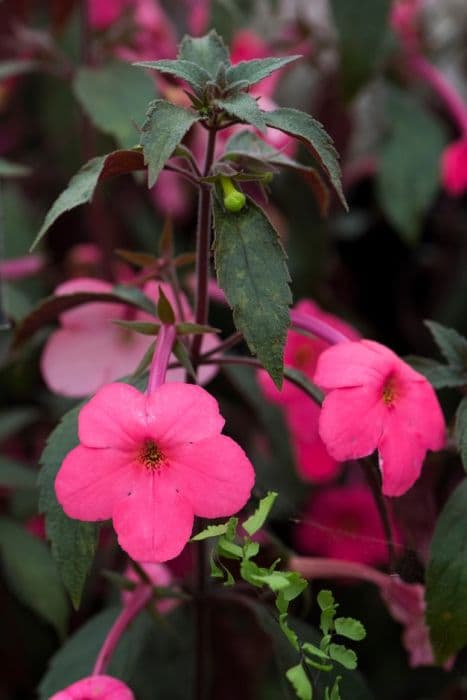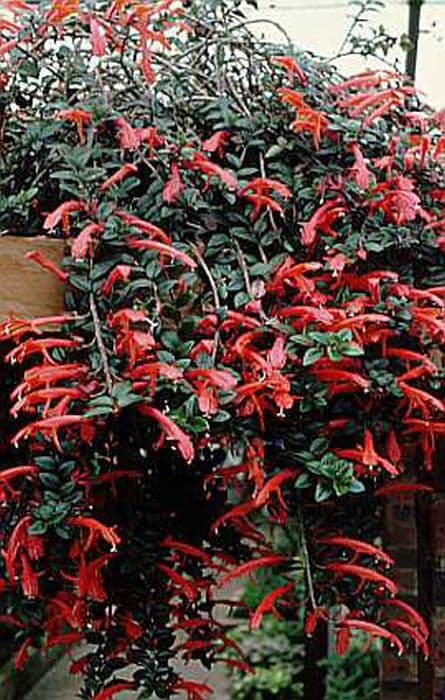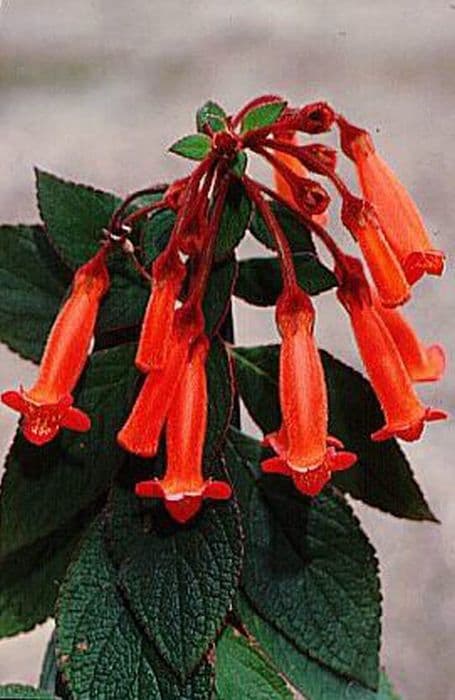Cape Primrose Streptocarpus 'Kim' (Av/d)

ABOUT
Streptocarpus 'Kim' (Av/d) is known for its attractive foliage and flowers. The plant produces lush, usually elongated leaves that are deep green in color, with a velvety or slightly textured surface adding to its visual appeal. These leaves often form a basal rosette, from which the flower stems emerge. The blossoms of Streptocarpus 'Kim' are particularly eye-catching, displaying a trumpet-like shape that's characteristic of the genus. The flowers come in a mix of hues, often showcasing variegated patterns or throats, with colors ranging from purples, blues, and pinks to whites and reds, depending on the particular hybrid variety. The blooms are usually arranged in clusters atop thin, delicate stalks that rise above the foliage, giving a striking contrast between the bold leaves and the dainty flowers. The overall appearance of Streptocarpus 'Kim' is one of vibrant color and lush texture, making it a popular choice for indoor decoration.
About this plant
 Names
NamesFamily
Gesneriaceae.
Synonyms
Cape Primrose, African Violet, Streptocarpella.
Common names
Streptocarpus 'Kim' (Av/d)
 Toxicity
ToxicityTo humans
The Streptocarpus 'Kim', commonly known as Cape Primrose, is not known to be toxic to humans. Consequently, there are typically no symptoms associated with the ingestion of this plant. It should still be used with the standard caution applied to all plants, as individual allergies or sensitivities can occur.
To pets
The Streptocarpus 'Kim', commonly referred to as Cape Primrose, is generally considered non-toxic to pets. Ingestion of this plant should not cause any significant symptoms of poisoning in pets. However, it is always advisable to prevent pets from consuming plants as a precaution and to monitor for any signs of gastrointestinal upset or allergic reactions.
 Characteristics
CharacteristicsLife cycle
Perennials
Foliage type
Evergreen
Color of leaves
Varies
Flower color
Varies
Height
1 foot (30 cm)
Spread
1 foot (30 cm)
Plant type
Herb
Hardiness zones
10
Native area
Africa
Benefits
 General Benefits
General Benefits- Easy to Care For: Streptocarpus 'Kim' requires minimal maintenance, making it suitable for beginner gardeners or those with busy schedules.
- Long Blooming Period: This variety often features a continuous display of flowers for much of the year, offering long-lasting visual appeal.
- Compact Size: Its modest size makes it perfect for indoor spaces such as windowsills and small apartments.
- Variety of Colors: Streptocarpus 'Kim' offers a range of flower colors, adding vibrancy and variety to home decor.
- Adaptability: It can thrive in various lighting conditions, from bright, indirect light to lower light environments.
 Medical Properties
Medical PropertiesThis plant is not used for medical purposes.
 Air-purifying Qualities
Air-purifying QualitiesThis plant is not specifically known for air purifying qualities.
 Other Uses
Other Uses- Art Projects: The unique patterns and shades of Streptocarpus flowers can inspire artists and be used as a motif for paintings, illustrations, or textile designs.
- Photography Subject: Gardeners and photographers may use Streptocarpus 'Kim' as a subject for macro photography due to its intricate flowers.
- Educational Tool: Because of its ease of propagation, Streptocarpus 'Kim' can be used in schools or educational workshops to teach propagation techniques.
- Culinary Decoration: The blossoms of Streptocarpus 'Kim' could be used to decorate desserts or dishes for special occasions, though they are not edible.
- Collectibles: Streptocarpus enthusiasts often collect different cultivars, including 'Kim', as a hobby akin to stamp collecting or coin collecting.
- Color Inspiration: The vibrant hues of Streptocarpus 'Kim' flowers can serve as inspiration for interior designers looking for color palettes.
- Symbolism: In floral language, Streptocarpus 'Kim' might be used to convey a special message due to its unique beauty and charm.
- Wedding Decor: This plant’s elegant flowers can complement wedding bouquets or centerpieces, particularly in themed weddings that emphasize botanical elements.
- Personalized Gifts: A potted Streptocarpus 'Kim' can be given as a gift symbolizing friendship or care due to its long-lasting blooms and hearty nature.
- Therapeutic Horticulture: Engaging with Streptocarpus 'Kim' during gardening can provide a sense of relaxation and achievement, helping to reduce stress.
Interesting Facts
 Feng Shui
Feng ShuiThe Cape Primrose is not used in Feng Shui practice.
 Zodiac Sign Compitability
Zodiac Sign CompitabilityThe Cape Primrose is not used in astrology practice.
 Plant Symbolism
Plant Symbolism- Persistence: Streptocarpus plants, often referred to as Cape Primrose, are known for their ability to bloom almost continuously throughout the year if given the proper care, symbolizing the trait of persistence and the rewards of consistent effort.
- Resilience: Cape Primrose is quite resilient and can bounce back even if it looks wilted or neglected, which represents one's ability to recover from challenging situations.
- Hope: With their bright and vibrant flowers, Streptocarpus can symbolize hope by bringing a sense of cheer and optimism to their surroundings.
- Adaptability: As a plant that can flourish in a range of environments, Cape Primrose symbolizes the ability to adapt to different circumstances life presents.
 Water
WaterCape Primrose requires consistent moisture, so water when the top inch of soil feels dry to the touch, typically every 5 to 7 days. Use room temperature water and apply it directly to the soil to avoid wetting the foliage, which can lead to fungal diseases. Water thoroughly until it starts to drain from the bottom of the pot, ensuring the roots are adequately saturated. For a medium-sized plant, you might use approximately 8-16 ounces of water, depending on the pot size and the environmental conditions. Reduce watering frequency during the winter months when the plant's growth slows down.
 Light
LightCape Primrose thrives in bright, indirect light. Place it near a north or east-facing window where it can receive plenty of light without being exposed to the harsh midday sun. Avoid direct sunlight, especially during the summer, as it can scorch the leaves and fade the flowers.
 Temperature
TemperatureCape Primrose prefers a temperature range between 60 and 75 degrees Fahrenheit. It can survive minimum temperatures of about 50 degrees Fahrenheit and should not be subjected to temperatures above 80 degrees Fahrenheit for extended periods. The ideal temperature range helps to encourage blooming and healthy foliage growth.
 Pruning
PruningCape Primrose benefits from pruning to remove faded or dead flowers and leaves, which promotes new growth and flowering. Prune regularly throughout the blooming season. The best time for a more extensive pruning is early spring or after the plant has finished a major flowering cycle to rejuvenate and shape the plant.
 Cleaning
CleaningAs needed
 Soil
SoilThe best soil mix for a Cape Primrose (Streptocarpus 'Kim') is a well-draining mixture such as one-part perlite to two parts peat-based soil. Maintain a soil pH of 5.5 to 6.5 for optimal growth.
 Repotting
RepottingCape Primroses should be repotted every 1-2 years or when they become pot-bound to ensure healthy growth and flowering.
 Humidity & Misting
Humidity & MistingCape Primroses thrive in moderate to high humidity levels, ideally around 50% to 60%. Avoid placing them in very dry environments.
 Suitable locations
Suitable locationsIndoor
Place in bright, indirect light and water when topsoil feels dry.
Outdoor
Partial shade, sheltered from wind and extreme weather.
Hardiness zone
10-11 USDA
 Life cycle
Life cycleStreptocarpus 'Kim', commonly known as Cape primrose 'Kim', begins its life cycle when seeds are sown in moist, well-draining soil and germinate, usually within a couple of weeks at warm temperatures. The seedlings develop into rosettes of long, narrow leaves, and once mature enough, they start to produce flowering stems. Flowers, which can come in a variety of colors depending on the hybrid, bloom mainly in spring and summer and can continue sporadically throughout the year in the right conditions. After pollination, which can occur through natural pollinators or manual intervention, the plant produces seed pods that, when mature, split open to release the seeds, completing the reproductive cycle. Cape primrose 'Kim' can also be propagated vegetatively through leaf cuttings, where a piece of a leaf is planted to produce a new plant genetically identical to the parent. Throughout the year, the plant may go through periods of active growth followed by dormancy, especially in climates with distinct seasonal changes.
 Propogation
PropogationPropogation time
Spring-Early Summer
Propogation: The Cape primrose 'Kim' can generally be propagated through leaf cuttings. This popular method involves taking a healthy leaf from the plant, cutting it into sections where each section has a vein. The cut edge is then dipped in rooting hormone powder to encourage root development. These sections are placed in a moist potting mix, ensuring that the cut edge is buried just below the surface. The pot with the cuttings must be kept in a warm place with indirect sunlight and covered with a plastic bag or placed in a propagator to maintain high humidity. In a few weeks, the sections will develop roots, and eventually, new shoots will emerge, indicating successful propagation. Once the new plantlets are of a sufficient size, they can be potted up into individual containers.









